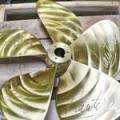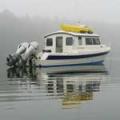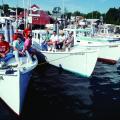Get Sailing!
A few simple rigging ideas to make sailing easier
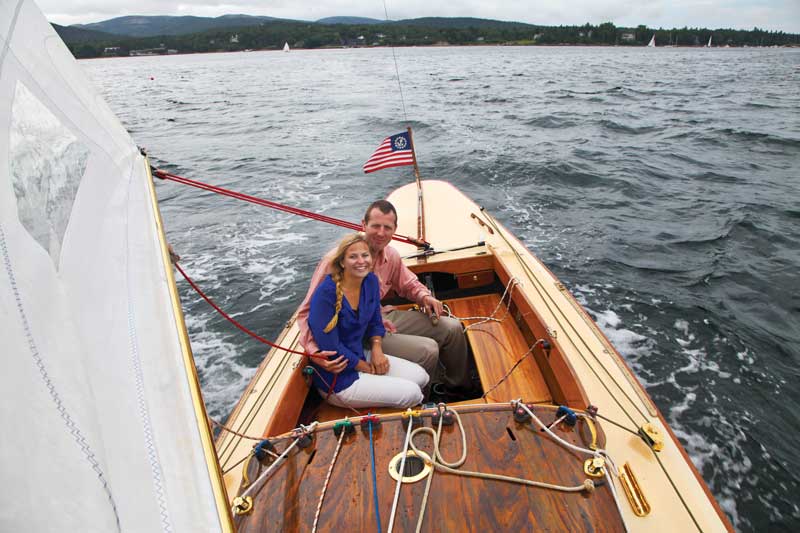 A head-knocker cleat on the boom leaves the cockpit clear. Here, the author's son Nathaniel holds the main sheet loosely while enjoying a sail on the Luders 16 Ludicrous with his wife Cassie. Photo courtesy Art Paine
A head-knocker cleat on the boom leaves the cockpit clear. Here, the author's son Nathaniel holds the main sheet loosely while enjoying a sail on the Luders 16 Ludicrous with his wife Cassie. Photo courtesy Art Paine
A well-attended yacht designer’s forum last winter in Thomaston and Rockland, Maine, was a bit of a wake-up call for people in the maritime world. As expected, eight esteemed yacht designers discussed their careers and technical side of design. The biggest topic, however, was how to get more people sailing.
There was mild debate about the causes of the apparent decline in sailing: difficulty, time constraints, physical challenge. My personal take is informed by my age. I’m still a fanatical sailboat racer, but limited time and aggravating physical effort may eventually force me over to “the dark side,” i.e. powerboats. In the meantime, I’ve been proactive in delaying that day by making small improvements to my own boat to make sailing easier and more enjoyable.
Most of these tips come from my time racing Ludicrous, my Luders 16. Some may be useful just for racing, others will make sense to anyone who likes to sail in small boats.
Mainsail Feeder: Many of us enjoy sailing more if we can get our mainsails up quickly and easily. My boat and most other racing boats require the luff rope of the mainsail to be fed into a cutaway slot in the back of the main mast. This can go badly, and almost always requires a crewmember’s help. I bit the bullet and expended $60 for a little “feeder” device that easily installs below the entry slot. Now I can singlehandedly feed the luff of my main with no snags by just hauling on the halyard.
In this modern day and age, many daysailers have either slides or slugs on their mainsail luffs that make this moot. Before I give up racing, I will probably have these affixed to my mainsail’s luff. 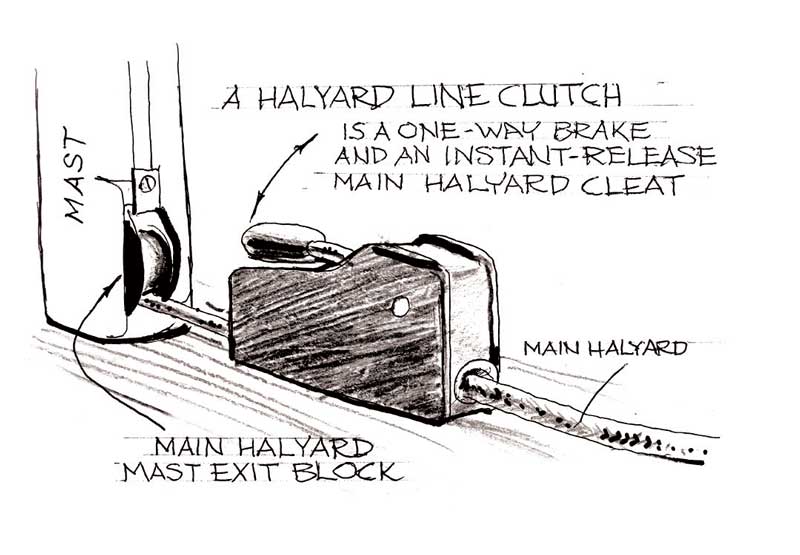 Using a line clutch on the main halyard speeds hoisting. Illustration by Art Paine
Using a line clutch on the main halyard speeds hoisting. Illustration by Art Paine
Line Clutch: Another little improvement was to install a “line clutch” behind the deck-level exit of the main halyard. When activated, the clutch acts like a brake to keep the halyard from slipping back. This “one way” device allows me to stand behind the main boom and hold the end of the boom extra high, making it easier to pull the sail all the way to the top.
Eliminate the Genoa Jib: There are many boats whose sail plans include both a genoa and a working jib. In all but light airs most sloops will perform equally well with the smaller working jib, which is easier to sheet, allows greater visibility, and is much easier to tack.
Roller Furler: Probably the biggest labor saver on any sloop is a jib roller furler. If you had to pick one recommendation of my list to do, this would be it. In addition to saving time at the end of the day, it also makes reducing sail area easy and quick, which is important for safety.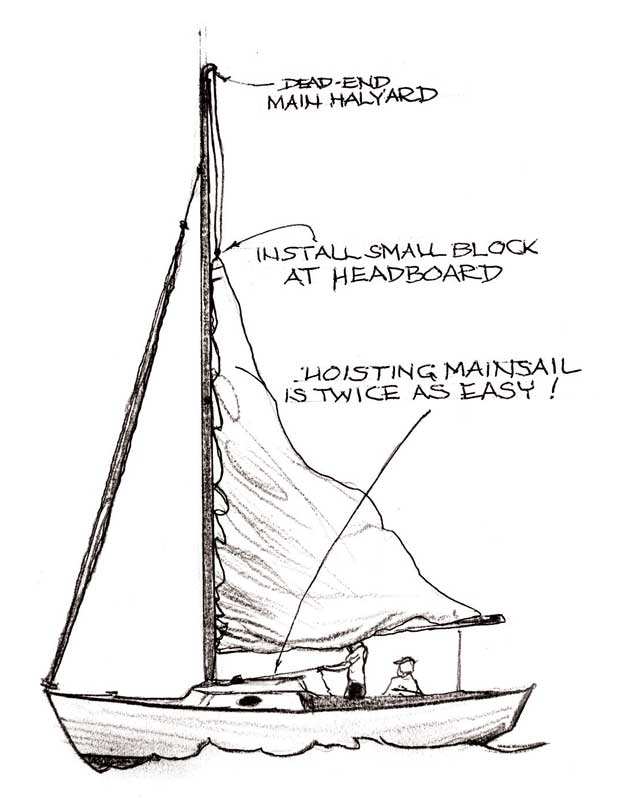 A two-part main halyard makes the sail seem featherweight when hauling it up. Illustration by Art Paine
A two-part main halyard makes the sail seem featherweight when hauling it up. Illustration by Art Paine
Lighter Sails: These days most new small sailboats have sails cut from lighter cloth, which makes them easier to hoist. I suggest avoiding full-batten mains, because they are much heavier and there’s more friction between the battens and the mast. Still, in many boats ranging from 20' to 30', the mainsail can be heavy and hard to lift. I recommend dead-ending the main halyard at the mast top and installing a small block on the main headboard. This means you will pull twice as much line when raising the sail, but it will be nearly twice as easy. Additionally, two rope parts will stretch less than one.
Head-Knocker Cleating: One advantage of racing is that competitors will chase efficiency in order to win. The lessons learned almost always make sailing easier. One example from the Luders fleet is the conversion of main sheets to so-called head-knocker cleating. The mainsail cam cleat is built into the final block in the mainsheet system, and hangs right off the boom. While I was originally skeptical, I’m now a big proponent of this gimmick. 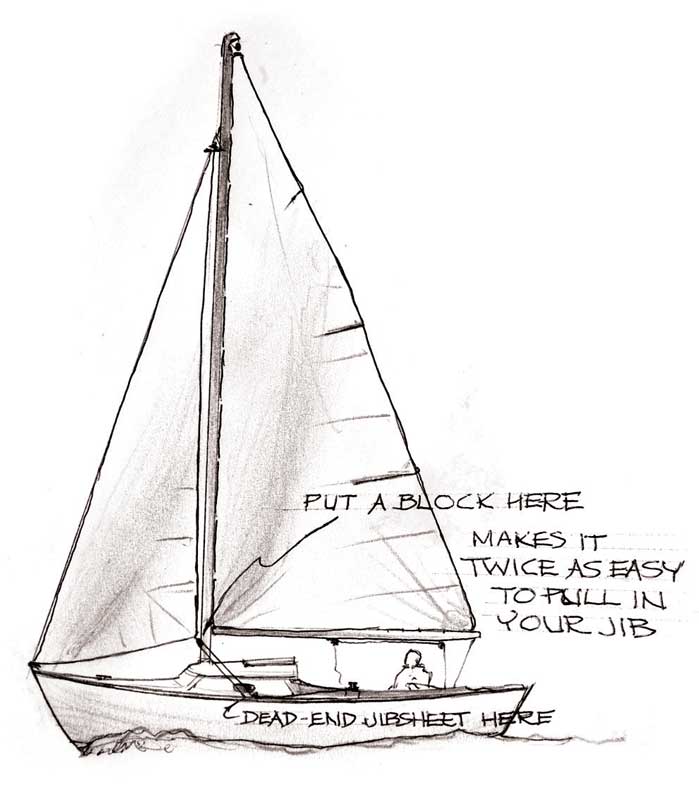 All sloops with blade jibs should try switching to double-purchase sheeting. Illustration by Art Paine
All sloops with blade jibs should try switching to double-purchase sheeting. Illustration by Art Paine
Double-Purchase Sheeting: This suggestion comes right from racing. Many boats with working jibs have switched over to a double-purchase for sheeting. This means dead-ending the jib sheet at a becket on a deck-based turning block, leading to a block on the jib clew, back to the turning block and then aft to a cam cleat. For any sailboat smaller than, say, 28 feet, this can eliminate the need to use a winch. It allows you to double your muscle power. Doing this still will require pulling the sheet into a cam cleat, but that’s easier and less confusing than remembering to wind the sheet (clockwise!) and into a self-tailer.
 Jib course-and-fine sheeting eliminates the need for a winch. Illustration by Art Paine
Jib course-and-fine sheeting eliminates the need for a winch. Illustration by Art Paine
Fine Sheeting: An additional labor-saver idea that I have stolen from racing is the idea of coarse-fine sheeting. Used mostly on jibs, and occasionally on mainsails, this idea completely eliminates winches. Initial “gross” sheeting of a jib is done as I just suggested, a two-to-one advantage being gained by virtue of a block on the jib clew. But instead of dead-ending the jib sheet on the track, that bitter end is led through a double block to a block-train located below decks. This tackle can have any number of parts, so that the final extra strain of putting leech tension on your jib can be rendered virtually effortless. It’s only a matter of a couple of expensive little blocks and a fair length of line, and an additional cam cleat for the fine-tune.
Easy Reefing System: Reefing a mainsail is seldom easy, and sometimes yields a less efficient shape. On my racer, I keep a special flatter and smaller mainsail. Mine was simply recut from an old mainsail, but even better would be a dedicated new, flat, heavy-air main. If weather looks blustery, this option works better than any reef possibly can. But if it’s too much work to remove one sail for another and you want to make do with one mainsail, you can install blocks at the front and rear slab reef cringles. This eliminates quite a bit of friction and gives a tighter, cleaner reef.
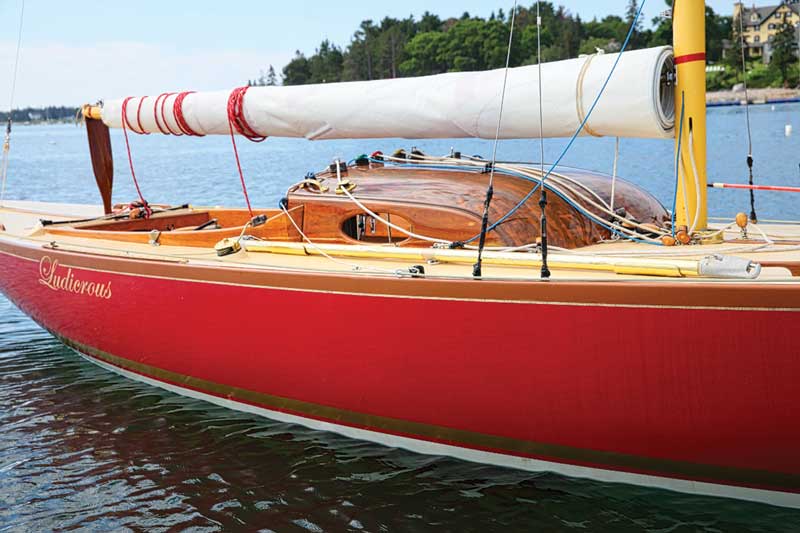 Rolling the main around the boom is an especially easy way to furl the sail. Photo courtesy Art Paine
Rolling the main around the boom is an especially easy way to furl the sail. Photo courtesy Art Paine
Easy Mainsail Furling: After sailing all afternoon, I’m a candidate for a couple of Tylenol. The last thing I want to do is fight with my mainsail. Plus I want to furl the sail in a way that introduces the fewest wrinkles and allows it to last longer. My solution was to install an old rolling pin boom gooseneck and attach the boom blocks with quick-release snap shackles. When I get to my mooring, I un-snap all my boom fittings, stand at the aft end of the boom and rotate it as the halyard is lowered. My mainsail rolls easily and smoothly out of the mast slot, with the boom acting as a mandrel, and of course this also keeps the sail from blowing overboard. In no time at all the sail is tightly rolled around the boom in such a way that no storm can disrupt it. All this only takes half a minute, and I can be on my way ashore. Best of all, I can do away with that third Tylenol.
Contributing Author Art Paine is a boat designer, fine artist, freelance writer, aesthete, and photographer who lives in Bernard, Maine.
Related Articles
Share this article:
2023 Maine Boat & Home Show

Join Us for the Maine Boat & Home Show!
Art, Artisans, Food, Fun & Boats, Boats, Boats
August 11 - 13, 2023 | On the waterfront, Rockland, Maine
Click here to pre-order your tickets.
Show is produced by Maine Boats, Homes & Harbors magazine.









